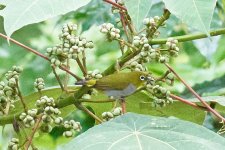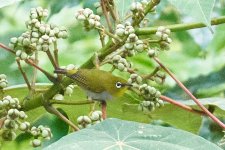-
Welcome to BirdForum, the internet's largest birding community with thousands of members from all over the world. The forums are dedicated to wild birds, birding, binoculars and equipment and all that goes with it.
Please register for an account to take part in the discussions in the forum, post your pictures in the gallery and more.
You are using an out of date browser. It may not display this or other websites correctly.
You should upgrade or use an alternative browser.
You should upgrade or use an alternative browser.
Oriental White-eye? Sarawak, Malaysian Borneo (1 Viewer)
- Thread starter dixonlau
- Start date
More options
Who Replied?There's no such species as Oriental White-eye any more - in a complex arrangement, it was spit into Indian and Swinhoe's. Indian doesn't reach Peninsular Malaysia, let alone Borneo, so the possibilities are Swinhoe's and Hume's (formerly known as Everett's). Hume's is best separated on habitat (it's a true forest species) but it has a thicker eye-ring with a more pronounced break at the front and a yellowish band running along the belly and linking the yellow throat to the yellow vent. The latter feature is obviously difficult to see in side profile views but I'm not seeing any sign of it here. Some images of Swinhoe's from Sarawak also show a yellow band running down the underparts, and birds there seem to be dark-tailed, making separation more difficult. Where did you see your bird?
dixonlau
Well-known member

It was taken in Borneo Tropical Rainforest Resort which also shared border with Lambir Hills National Park, Miri. Therefore species that found in national park may as well appear at the resort's forest.There's no such species as Oriental White-eye any more - in a complex arrangement, it was spit into Indian and Swinhoe's. Indian doesn't reach Peninsular Malaysia, let alone Borneo, so the possibilities are Swinhoe's and Hume's (formerly known as Everett's). Hume's is best separated on habitat (it's a true forest species) but it has a thicker eye-ring with a more pronounced break at the front and a yellowish band running along the belly and linking the yellow throat to the yellow vent. The latter feature is obviously difficult to see in side profile views but I'm not seeing any sign of it here. Some images of Swinhoe's from Sarawak also show a yellow band running down the underparts, and birds there seem to be dark-tailed, making separation more difficult. Where did you see your bird?
After done more digging based on your giving answers, I do agreed on Swinhoe's and Hume's.
I've found another not so clear shot that partially can see its under-bill and partial throat. There is one darker line below its bill. Not sure if that could give additional hint for the ID.
Dark-tailed can be clearly seen in previous 2 photos.
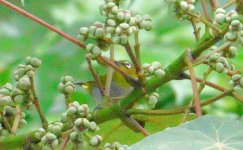
I posted a reply a couple of days ago, but then deleted it because I had misremembered - I had it in my head that 'Warbling White-eye' was a combination of Japanese White-eye and White-eyes from Borneo, whereas it appears to be a combination of Japanese White-eye and other White-eyes that are present in all the territories around Borneo, but not at all in Borneo itself (which I find surprising, but sometimes I am easy to surprise). Now, looking at various photos online, I think Dixon's bird is good for Hume's.
Question: having looked at the distribution maps for Warbling, Swinhoe's and Hume's, can I have an armchair tick of Hume's for the bird photoed below, seen in central Hanoi, which was the only White-eye we saw in a week in Vietnam and Laos in 2011? At the time the books and so on said it was Japanese White-eye.
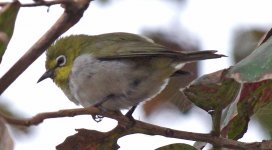
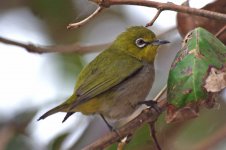
Question: having looked at the distribution maps for Warbling, Swinhoe's and Hume's, can I have an armchair tick of Hume's for the bird photoed below, seen in central Hanoi, which was the only White-eye we saw in a week in Vietnam and Laos in 2011? At the time the books and so on said it was Japanese White-eye.


I'm unsure about the OP bird. The new image clearly shows that the yellow band running down the belly is absent, which should make it Swinhoe's. On the other hand, the throat doesn't look contrastingly yellow and the underparts look quite grey. The few photos of Hume's from Sarawak on eBird show a couple of individuals which look confusingly like Swinhoe's: Hume's White-eye - Zosterops auriventer - Media Search - Macaulay Library and eBird. However, as one of the birds was photographed by Dave Bakewell, it's certainly not misidentified. Images of Swinhoe's from Sarawak show birds with yellower tones on the upperparts and a more extensive yellow throat, but some have a thick eye-ring and yellow ventral stripe. Swinhoe's White-eye - Zosterops simplex - Media Search - Macaulay Library and eBird.
@MacNara White-eyes in Hanoi are Swinhoe's - I had a good look at them and satisfied myself that's what they are. Hume's is not present in Vietnam and is any case a forest species. Birds in the north-west are another matter!
@MacNara White-eyes in Hanoi are Swinhoe's - I had a good look at them and satisfied myself that's what they are. Hume's is not present in Vietnam and is any case a forest species. Birds in the north-west are another matter!
Last edited:
Thanks, Andy.
I seem to be completely muddled in my head about these, and got them back to front again (as in my deleted post)!
I thought Dixon's bird looks good for Swinhoe's (and writing 'Hume's' was an error) and thus my bird in Hanoi also (and I had looked at the distribution maps on 'Birds of the World' where they are in quite different places). Maybe it's because I find the new name for our local birds in Japan - Warbling White-eye - so ugly that I mix up this group so easily. (Also, I'm annoyed that 'Birds of the World' has become so American since 'Handbook of Birds of the World' was taken over by Cornell - the video and two of the three photos of Warbling White-eye on the top page for this bird are from Hawaii!)
I think that the second photo in Dixon's original post shows a clear contrasting yellow throat (the same colour as the uppertail coverts). The photos are not great quality, but good enough.
Just on a side-note: I thought that the current trend was to give birds (and other animals) neutral English names or names based on the name of the bird in the language of some group of people where they are found and not to use the name of their European 'discoverer', but that seems to have been ignored in the case of Hume's and Swinhoe's.
I seem to be completely muddled in my head about these, and got them back to front again (as in my deleted post)!
I thought Dixon's bird looks good for Swinhoe's (and writing 'Hume's' was an error) and thus my bird in Hanoi also (and I had looked at the distribution maps on 'Birds of the World' where they are in quite different places). Maybe it's because I find the new name for our local birds in Japan - Warbling White-eye - so ugly that I mix up this group so easily. (Also, I'm annoyed that 'Birds of the World' has become so American since 'Handbook of Birds of the World' was taken over by Cornell - the video and two of the three photos of Warbling White-eye on the top page for this bird are from Hawaii!)
I think that the second photo in Dixon's original post shows a clear contrasting yellow throat (the same colour as the uppertail coverts). The photos are not great quality, but good enough.
Just on a side-note: I thought that the current trend was to give birds (and other animals) neutral English names or names based on the name of the bird in the language of some group of people where they are found and not to use the name of their European 'discoverer', but that seems to have been ignored in the case of Hume's and Swinhoe's.

If you want to look into the history of how the birds got their name etc, there is a thread in the taxonomy part of the forum which discussed that, starting around post 80 in this thread:Just on a side-note: I thought that the current trend was to give birds (and other animals) neutral English names or names based on the name of the bird in the language of some group of people where they are found and not to use the name of their European 'discoverer', but that seems to have been ignored in the case of Hume's and Swinhoe's.

Zosteropidae
Putting aside the question of desirability, isn't it correct to say that there should already be sufficient specimen material to validly describe Wangi Wangi White-eye in accordance with ICZN rules? Putting aside the question of desirability, a photo is enough.
And here is a thread discussing how to differentiate Hume's from Swinhoe's

Hume's white-eye from gallery
Dear all, subspecies auriventer from the past Oriental White-eye and a couple of subspecies from Everett's White-eye have been combined into Hume's White-eye. The question is if we have any images in the gallery that actually show that species. I have looked and mainly by range identified a few...
Niels
Hi Niels; thanks for those interesting links.If you want to look into the history of how the birds got their name etc, there is a thread in the taxonomy part of the forum which discussed that, starting around post 80 in this thread:

Zosteropidae
Putting aside the question of desirability, isn't it correct to say that there should already be sufficient specimen material to validly describe Wangi Wangi White-eye in accordance with ICZN rules? Putting aside the question of desirability, a photo is enough.www.birdforum.net
And here is a thread discussing how to differentiate Hume's from Swinhoe's

Hume's white-eye from gallery
Dear all, subspecies auriventer from the past Oriental White-eye and a couple of subspecies from Everett's White-eye have been combined into Hume's White-eye. The question is if we have any images in the gallery that actually show that species. I have looked and mainly by range identified a few...www.birdforum.net
Niels
I'm annoyed by the name Warbling White-eye because it seems to link two groups which each have a lot of members (Warblers and White-eyes).
But I'm also annoyed because the major component of the Warbling White-eye is what used to be the Japanese White-eye, and yet the new name is difficult for Japanese to pronounce.
'Warbling' would be pronounced Wa-bu-ringu (short 'a') on sight by some, possibly War-bu-ringu (long 'a') by some, Wa-ru-bu-ringu by others, and regarded as unpronouncable by yet others. 'Wobbling', for that matter would be pronounced almost the same. It seems a bit thoughtless and careless not to choose a name that can be easily pronounced by the locals in the area where the bird is most commonly found.
The Japanese name for the bird, 'Mejiro' just means 'Eye-white' (reversed from English because of grammar, just as it would be Oeuil-blanc in French, except I think they use Zosterops). But almost all Japanese bird books have an English language index as well as a binomial index.
James Eaton
Trent Valley Crew
Narrow orbital ring (especially above eye), and dull olive-green upperparts = Hume's White-eye. Swinhoe's would have a much broader orbital ring + show a yellower supraloral stripe.
James
James
Thanks for this, James. Someone else drew my attention to the yellow supraloral feature, which is definitely lacking on the OP bird. @MacNara This feature is clearly visible on the images you posted. I may also need to revise my earlier comment about the lack of a ventral stripe - looking carefully at the 3rd image, it seems that the start of this stripe/band is just be visible and the reason we can't see more of it may be that the bird is twisting its body.
I'm not sure I agree that Swinhoe's can be identified by its thicker orbital ring. The first time I saw Hume's, I found the orbital ring to be rather distinct. This may be because the lower half is often thicker than the upper half and stands out if you're looking up at the bird. Looking at online images of Swinhoe's, generally the orbital ring is of uniform thickness, but can be less distinct than on the OP bird. MacNara's bird is another example of this. I suspect there's individual and maybe regional variation, and the viewing angle may come into it.
I'm not sure I agree that Swinhoe's can be identified by its thicker orbital ring. The first time I saw Hume's, I found the orbital ring to be rather distinct. This may be because the lower half is often thicker than the upper half and stands out if you're looking up at the bird. Looking at online images of Swinhoe's, generally the orbital ring is of uniform thickness, but can be less distinct than on the OP bird. MacNara's bird is another example of this. I suspect there's individual and maybe regional variation, and the viewing angle may come into it.
James: Thank you for this comment.Narrow orbital ring (especially above eye), and dull olive-green upperparts = Hume's White-eye. Swinhoe's would have a much broader orbital ring + show a yellower supraloral stripe.
James
Looking at my own photos posted above, I can clearly see the yellow supraloral which otherwise I would have thought was 'just one of those things', and looking around at various internet photos, this seems to be a good feature. I'm less convinced about the eye-ring thickness, but on the other hand if James Eaton thinks it's a useful feature, then I am not qualified to disagree.
Andy: Thanks for taking the trouble to look at my photos. (But I think you are being really optimistic in getting a yellow ventral stripe from Dixon's photo three which has a lot of photo artefacts and is of lower quality than the other two photos - I think the features which James pointed to are enough anyway.)
DixonLau: Apologies for partially hi-jacking your thread, but at least you got a definite ID, and I learned something, and Andy did too, I think. So drinks all around!
James Eaton
Trent Valley Crew
The orbital ring feature is more of a Sundiac taxa feature, as the northerly races have a slightly narrower orbital. I wrote this in the Indonesian Archipelago field guide:James: Thank you for this comment.
Looking at my own photos posted above, I can clearly see the yellow supraloral which otherwise I would have thought was 'just one of those things', and looking around at various internet photos, this seems to be a good feature. I'm less convinced about the eye-ring thickness, but on the other hand if James Eaton thinks it's a useful feature, then I am not qualified to disagree.
Andy: Thanks for taking the trouble to look at my photos. (But I think you are being really optimistic in getting a yellow ventral stripe from Dixon's photo three which has a lot of photo artefacts and is of lower quality than the other two photos - I think the features which James pointed to are enough anyway.)
DixonLau: Apologies for partially hi-jacking your thread, but at least you got a definite ID, and I learned something, and Andy did too, I think. So drinks all around!
Swinhoe’s White-eye overlaps at lower elevations; Hume’s best told by (1) darker ‘grey-vested’ appearance with wide and distinct yellow median belly wedge (versus Swinhoe’s whiter underparts with narrower yellow median-belly line often interrupted towards vent), (2) lack of contrasting yellow supraloral stripe on olive crown (present in Swinhoe’s), (3) on average less bright, greener upperparts (especially rump) than Swinhoe’s, (4) shorter, blunter bill, (5) narrower eye-ring (lower portion’s width roughly 50-70% of eye’s diameter, versus roughly equal width to eye’s diameter in Swinhoe’s). See also Black-capped White-eye.
I also a little identification piece on Facebook too, viewable here, which discusses the Vietnamese birds too:
Cheers
James
dixonlau
Well-known member

In fact, I am very much appreciated.DixonLau: Apologies for partially hi-jacking your thread, but at least you got a definite ID, and I learned something, and Andy did too, I think. So drinks all around!
Also thanks to @James Eaton @andyb39 @njlarsen for participating in the topic. All points noted. Something can't learn by myself by just googling.
Users who are viewing this thread
Total: 2 (members: 0, guests: 2)




